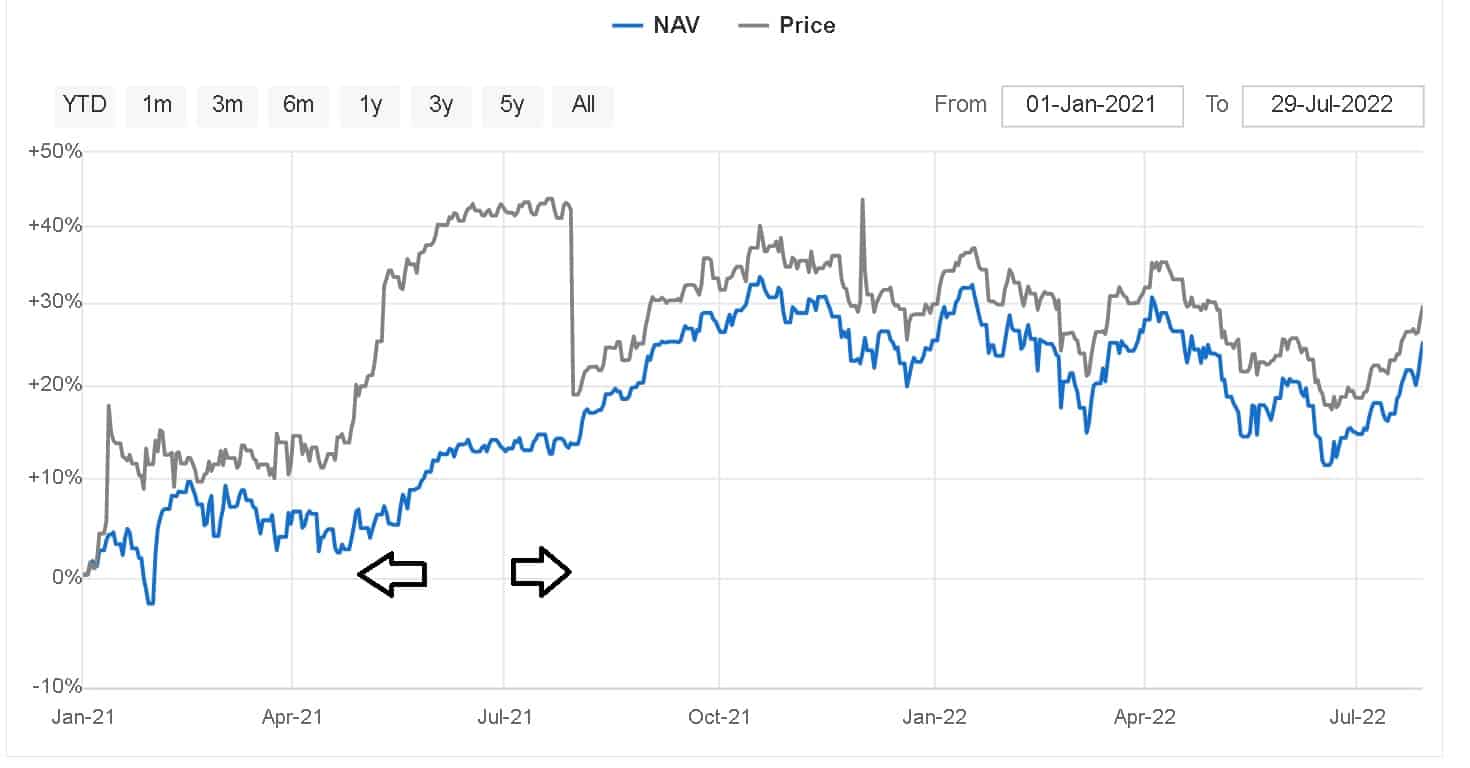Last Updated on September 5, 2022 at 4:12 pm
In this article, we explain why conventional ways of measuring ETF tracking errors can be misleading and present an alternative.
The efficiency of a passive fund (index fund or ETF) is measured by the tracking error or tracking difference. The tracking difference is simply the fund return minus benchmark return. This must be a small negative number. Negative because expenses will always reduce returns. If the difference is positive, then it means the fund has beat the benchmark. This can happen only if the tracking is not efficient. See: Six Index Funds “Outperform” their benchmarks in the last year! Also, see Ten Index funds with the largest return deviation over the past year.
To understand how tracking error is measured, we must understand how a standard deviation is measured. Consider a set of fund monthly returns. We first find out the average monthly return. Then we find out how much individual monthly returns have deviated from the average. A standard deviation is the “average” of such individual deviations. Instead of a conventional average which can be positive or negative, the standard deviation is always defined to be positive. To do this, the square of the individual deviation is used.
Let us see how this is done with an example. Take three numbers 1,3,5.
Join 32,000+ readers and get free money management solutions delivered to your inbox! Subscribe to get posts via email! (Link takes you to our email sign-up form)
🔥Want to create a complete financial plan? Learn goal-based investing? Exclusive access to our DIY tools? Increase your income with your skills? Enjoy massive discounts on our robo-advisory tool & courses! 🔥
The average is 3.
The deviation of each number from the average is
(1-3) ; (3-3); (5-3) or -2,0,2
Now take the square of each deviation
(-2)^2, 0^2, 2^2 or 4,0,4
The average of the deviation squared is (4+0+4)/3
The standard deviation is the square root of (4+0+4)/3
The actual definition used is (4+0+4)/(3-1) = 8/2 =4. That is, if there are N numbers (3 in the example), N-1 is used. The reason for this is explained here: Bessel’s correction.
To compute the tracking error, we replace the numbers by return differences.
For example over three months, the fund/ETF has a (monthly) return of 0.9%, 0.8%, 0.1%. The corresponding index returns are 1.1%, 1.2%, and 0.5%.
The differences are (0.9%-1.1%), (0.8% – 1.2%) and (0.1%-0.5%).
We compute the square of these differences:
(0.9%-1.1%)^2, (0.8% – 1.2%)^2 and (0.1%-0.5%)^2
The sum of these squares is 0.0036%
Tracking error = Square root of [0.0036%/(3-1)] = 0.42% Here 3-1 refers to total number of number (3) minus 1.
There is just the NAV for an index fund, so there is no problem when we talk about return deviations or tracking errors. For an ETF, though, we have a price which is used for day-to-day buying and selling, and there is a NAV. The ETF price determines the return for retail investors, not the ETF NAV.
Inspite of this, all ETF returns, and tracking errors are computed only with the NAV and not the price. It is well known that for many ETFs, the price can differ from the NAV significantly, and this difference can last for weeks or months.
Let us see how this can be misleading.
Let us take LIC MF Nifty 50 ETF as an example.
The tracking errors using ETF NAV over the 1,2,3,4 and 5 years, respectively, are:
0.0139%, 0.0268%, 0.0366%, 0.0328%, 0.0307%
That does not seem so bad, is it? After all, SBI NIfty 50 ETF had a much higher NAV tracking error over 2Y: 0.3848%
Things look quite different when we calculate the tracking error using ETF price.
The tracking errors using LIC MF Nifty 50 ETF price for over the 1,2,3,4 and 5 years, respectively, are:
5.2000% 4.9588% 4.1237% 3.5984% 3.2577%
Notice the huge difference! This is because the price has fluctuated significantly. This is a screenshot from Value Research of the price vs NAV deviation in 2021.

SBI Nifty ETF tracking error based on price is only 0.4094% over the last 2Y, which is only a bit higher than the NAV tracking error based on NAV: 0.3848%.
SBI has done a much better job handling price-nav deviation than LIC in spite of handling EPFO investments and redemptions.
The NAV-based tracking errors can be quite misleading. One will have to look at the volumes traded or “see” the price-nav chart to appreciate the efficacy of an ETF. Instead of these crude estimates, a price-based tracking error and tracking deviation can instantly tell us whether an ETF is worthy of investment or not.
Even for Nifty Bees, one of the well-managed ETFs, the price-based tracking error is 2870 times higher than the nav-based tracking error over the last year!
The solution: Regular readers may be aware that we publish tracking errors and tracking deviation for index funds over the last 1,2,3… 7.8.9 years on a monthly basis.
This is our new ETF tracking error and tracking deviation screener based on NAV and price to address this problem.
In summary, we have shown that ETF-based tracking error data does not capture the actual price-nav deviations seen in an ETF. Since the price determines investor gain or loss, tracking errors and tracking deviations should also be based on ETF price.
🔥Enjoy massive discounts on our courses, robo-advisory tool and exclusive investor circle! 🔥& join our community of 7000+ users!
Use our Robo-advisory Tool for a start-to-finish financial plan! ⇐ More than 2,500 investors and advisors use this!
Track your mutual funds and stock investments with this Google Sheet!
We also publish monthly equity mutual funds, debt and hybrid mutual funds, index funds and ETF screeners and momentum, low-volatility stock screeners.





- Do you have a comment about the above article? Reach out to us on Twitter: @freefincal or @pattufreefincal
- Have a question? Subscribe to our newsletter using the form below.
- Hit 'reply' to any email from us! We do not offer personalized investment advice. We can write a detailed article without mentioning your name if you have a generic question.
Join 32,000+ readers and get free money management solutions delivered to your inbox! Subscribe to get posts via email! (Link takes you to our email sign-up form)
About The Author
 Dr M. Pattabiraman(PhD) is the founder, managing editor and primary author of freefincal. He is an associate professor at the Indian Institute of Technology, Madras. He has over ten years of experience publishing news analysis, research and financial product development. Connect with him via Twitter(X), Linkedin, or YouTube. Pattabiraman has co-authored three print books: (1) You can be rich too with goal-based investing (CNBC TV18) for DIY investors. (2) Gamechanger for young earners. (3) Chinchu Gets a Superpower! for kids. He has also written seven other free e-books on various money management topics. He is a patron and co-founder of “Fee-only India,” an organisation promoting unbiased, commission-free investment advice.
Dr M. Pattabiraman(PhD) is the founder, managing editor and primary author of freefincal. He is an associate professor at the Indian Institute of Technology, Madras. He has over ten years of experience publishing news analysis, research and financial product development. Connect with him via Twitter(X), Linkedin, or YouTube. Pattabiraman has co-authored three print books: (1) You can be rich too with goal-based investing (CNBC TV18) for DIY investors. (2) Gamechanger for young earners. (3) Chinchu Gets a Superpower! for kids. He has also written seven other free e-books on various money management topics. He is a patron and co-founder of “Fee-only India,” an organisation promoting unbiased, commission-free investment advice.Our flagship course! Learn to manage your portfolio like a pro to achieve your goals regardless of market conditions! ⇐ More than 3,000 investors and advisors are part of our exclusive community! Get clarity on how to plan for your goals and achieve the necessary corpus no matter the market condition is!! Watch the first lecture for free! One-time payment! No recurring fees! Life-long access to videos! Reduce fear, uncertainty and doubt while investing! Learn how to plan for your goals before and after retirement with confidence.
Our new course! Increase your income by getting people to pay for your skills! ⇐ More than 700 salaried employees, entrepreneurs and financial advisors are part of our exclusive community! Learn how to get people to pay for your skills! Whether you are a professional or small business owner who wants more clients via online visibility or a salaried person wanting a side income or passive income, we will show you how to achieve this by showcasing your skills and building a community that trusts and pays you! (watch 1st lecture for free). One-time payment! No recurring fees! Life-long access to videos!
Our new book for kids: “Chinchu Gets a Superpower!” is now available!


Must-read book even for adults! This is something that every parent should teach their kids right from their young age. The importance of money management and decision making based on their wants and needs. Very nicely written in simple terms. - Arun.Buy the book: Chinchu gets a superpower for your child!
How to profit from content writing: Our new ebook is for those interested in getting side income via content writing. It is available at a 50% discount for Rs. 500 only!
Do you want to check if the market is overvalued or undervalued? Use our market valuation tool (it will work with any index!), or get the Tactical Buy/Sell timing tool!
We publish monthly mutual fund screeners and momentum, low-volatility stock screeners.
About freefincal & its content policy. Freefincal is a News Media Organization dedicated to providing original analysis, reports, reviews and insights on mutual funds, stocks, investing, retirement and personal finance developments. We do so without conflict of interest and bias. Follow us on Google News. Freefincal serves more than three million readers a year (5 million page views) with articles based only on factual information and detailed analysis by its authors. All statements made will be verified with credible and knowledgeable sources before publication. Freefincal does not publish paid articles, promotions, PR, satire or opinions without data. All opinions will be inferences backed by verifiable, reproducible evidence/data. Contact information: To get in touch, use this contact form. (Sponsored posts or paid collaborations will not be entertained.)
Connect with us on social media
- Twitter @freefincal
- Subscribe to our YouTube Videos
- Posts feed via Feedburner.
Our publications
You Can Be Rich Too with Goal-Based Investing
 Published by CNBC TV18, this book is meant to help you ask the right questions and seek the correct answers, and since it comes with nine online calculators, you can also create custom solutions for your lifestyle! Get it now.
Published by CNBC TV18, this book is meant to help you ask the right questions and seek the correct answers, and since it comes with nine online calculators, you can also create custom solutions for your lifestyle! Get it now.Gamechanger: Forget Startups, Join Corporate & Still Live the Rich Life You Want
 This book is meant for young earners to get their basics right from day one! It will also help you travel to exotic places at a low cost! Get it or gift it to a young earner.
This book is meant for young earners to get their basics right from day one! It will also help you travel to exotic places at a low cost! Get it or gift it to a young earner.Your Ultimate Guide to Travel
 This is an in-depth dive into vacation planning, finding cheap flights, budget accommodation, what to do when travelling, and how travelling slowly is better financially and psychologically, with links to the web pages and hand-holding at every step. Get the pdf for Rs 300 (instant download)
This is an in-depth dive into vacation planning, finding cheap flights, budget accommodation, what to do when travelling, and how travelling slowly is better financially and psychologically, with links to the web pages and hand-holding at every step. Get the pdf for Rs 300 (instant download)